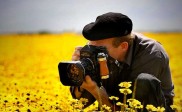Common Landscape Photography Mistakes
Almost every photographer has taken, at least once in their life time, a landscape photo. Because it is a very common form of photography, mistakes are also very common when photographing landscape. Knowing these mistakes and avoiding them will help you achieve better landscape photos.
1. Choosing the wrong time of the day to take the photo.
Light is the key element in any type of photography, and if you are interested in landscape photography, you should choose the time of day when the sunlight is appropriate for taking photos. You don’t want to photograph a beautiful landscape at noon when the sun is very powerful, as the surroundings will not seem very natural under that kind of light. Instead, try shooting in the morning or in the evening. The early morning light is better because the morning sky usually has fewer clouds, and since the sun is in a lower position, you will get interesting shadows.
2. Composition Mistakes.
Placing an element, like a tree, in the middle of your image will not get you an interesting photograph. Instead, try to keep in mind the rule of thirds, which is very important in landscape photography. The elements of the composition can be combined in many ways but choosing the right placement for the key objects will provide you with a more impressive image. However, there are instances when you should break the rules to get interesting shots.

Photo by Voland14
3. Framing Mistakes.
You should be careful not to include any unwanted elements in your frame, like a trashcan or some overhead wires. However, don’t be afraid to include in the frame natural elements like tree branches, even if they enter the frame from the top or from the sides. Because combining these elements with the rest of the landscape can make the picture look more interesting.
4. Making the wrong camera settings.
It’s easy to get lost in the many settings of a digital camera, especially if you use a DSLR. Many cameras have a landscape mode. However, if you just point and shoot you won’t get the most of your camera. If you use manual settings you should experiment until you get the right combination. Try to set a low ISO value for best image quality, a medium to small aperture, (f/8 – f/11) to get a large depth of field, and a fast shutter speed to avoid camera shake. If you need slow shutter speeds for proper exposures, always use a tripod. Also, consider setting the white balance properly. Use the sunny mode for clear sunny days, the cloudy mode if it’s cloudy, and so on. If you are not sure you can leave the setting on the automatic mode and shoot in RAW to be able to do adjustments in post processing.
5. Using flash.
Unless you want to brighten a foreground object, which isn’t a common thing when shooting landscape, you will want to turn off the flash of your camera. Shooting with the flash turned on, towards a far subject will not provide your image with better lightning. Instead, it can cause flare if the scene contains fog, mist or dust.
You may want to take a look at Dealing with Light and Composition in Landscape Photography




timing my photos is more of when i can get to the location so i always shoot in whatever light is available
great illustrated tips. it is A big help for all photographer . thank you for sharing knowledge .